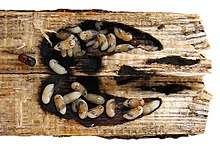Xylosandrus crassiusculus
Xylosandrus crassiusculus, known generally as the Asian ambrosia beetle or granulate ambrosia beetle, is a species of tropical bark beetle in the family Curculionidae.[1][2][3][4] It is native to Asia and has spread to Africa, Europe, Australasia and the Americas. The adult beetle is reddish-brown and some 2 to 3 mm (0.08 to 0.12 in) long.[5]
| Xylosandrus crassiusculus | |
|---|---|
 | |
| Larvae of the granulate ambrosia beetle | |
| Scientific classification | |
| Kingdom: | Animalia |
| Phylum: | Arthropoda |
| Class: | Insecta |
| Order: | Coleoptera |
| Family: | Curculionidae |
| Genus: | Xylosandrus |
| Species: | X. crassiusculus |
| Binomial name | |
| Xylosandrus crassiusculus (Motschulsky, 1866) | |
| Synonyms | |
| |
Distribution and habitat
This beetle is native to Asia, and has spread to other parts of the world as an invasive species in Africa, the Americas, Europe and Oceania.[5] It was first reported in the southeastern United States in 1974, had reached Costa Rica by 1996, Panama by 2003, and Guatemala and northern Brazil by 2008. It appeared in Argentina in 2001, nearly a decade before it was detected in southern Brazil and Uruguay; as the latter two countries were vigilant, with long-term trapping programmes, the Argentine collection may represent a direct introduction from a non-American source, with the insects later spreading northwards up the coast.[6]
Life cycle
Females mate with their siblings before leaving the galleries. Although males are flightless, females can fly and disperse to other potential host trees. Here they excavate tunnels and lay eggs. The larvae develop and enlarge the galleries and the female stays with the brood, overwintering there.[5]
Ecology
Although the larvae of ambrosia beetles develop in cavities in wood, the food of both adults and larvae is exclusively a symbiotic fungus which the female beetle introduces into the tunnels and galleries she excavates. In the case of Xylosandrus crassiusculus, the fungus has been identified as Ambrosiella roeperi. It has been shown that the beetle is attracted to the smell of this fungus, which may concentrate attacks on specific trees. The beetle can infest branches as small as 1.5 cm (0.6 in) across and trunks 2.5 to 6 cm (1.0 to 2.4 in) in diameter.[5]
This beetle is polyphagous, infesting many species of host trees. It is usually restricted to stressed young trees and nursery stock, but sometimes attacks apparently healthy young trees. It additionally infests stacked timber, where it causes economic damage.[6] In the United States, trees and shrubs infested include oak, cherry and crape myrtle, as well as pecan, peach, plum, persimmon, elm, sweet gum, magnolia, fig, buckeye and sweet potato.[7] In Europe its host is the carob (Ceratonia siliqua), while in Israel, where the carob grows, its only known host is the Palestine oak (Quercus calliprinos).[5]
References
- "Xylosandrus crassiusculus Report". Integrated Taxonomic Information System. Retrieved 2018-04-21.
- "Xylosandrus crassiusculus species details". Catalogue of Life. Archived from the original on 2018-07-03. Retrieved 2018-04-21.
- "Xylosandrus crassiusculus". GBIF. Archived from the original on 2018-07-03. Retrieved 2018-04-21.
- "Xylosandrus crassiusculus Species Information". BugGuide.net. Archived from the original on 2018-07-03. Retrieved 2018-04-21.
- Tuffen, M.G. (2015). "Rapid Pest Risk Analysis (PRA) for Xylosandrus crassiusculus". Defra. Retrieved 31 May 2015.
- Oberprieler, Rolf; Marvaldi, Adriana; Lyal, Chris (2019). Systematics and Phylogeny of Weevils: Volume 2. MDPI. p. 302. ISBN 978-3-03897-668-4.
- Forest Insect and Disease Conditions in the United States. United States Forestry Service. 2006. p. 85.
Further reading
- Lobl, I.; Smetana, A., eds. (2013). Catalogue of Palaearctic Coleoptera, Volume 7: Curculionoidea I. Apollo Books. ISBN 978-90-04-26093-1.
- Lobl, I.; Smetana, A., eds. (2013). Catalogue of Palaearctic Coleoptera, Volume 8: Curculionoidea II. Apollo Books. ISBN 978-90-04-25916-4.
External links
